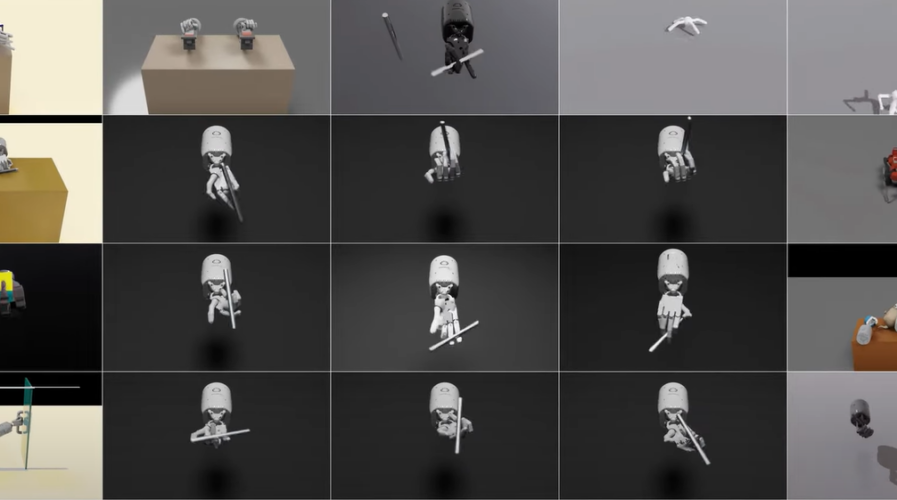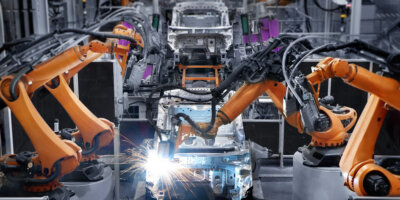
NVIDIA teaches robots human tricks. (Source – YouTube)
The NVIDIA Eureka masters human-like pen-spinning tricks, redefining AI learning
|
Getting your Trinity Audio player ready... |
- NVIDIA Eureka represents a new era in robotics, redefining AI training standards by using LLMs to teach robots complex tasks.
- Eureka excels in teaching robots detailed pen-spinning, achieving human-like precision and skill in robotics.
The realm of robotics is advancing astonishingly, with robots now capable of executing intricate tasks such as dexterous ‘spinny pen’ tricks with their mechanical hands. These advancements are rapidly closing the gap between human and robotic abilities. A recent blog by NVIDIA highlights an AI agent that employs Large Language Models (LLMs) to craft reward algorithms automatically, a crucial step in training robots to undertake complex tasks.
NVIDIA Research has developed a new AI agent capable of instructing robots in sophisticated skills, achieving a milestone by training a robotic hand to execute fast-paced pen-spinning tricks on par with human proficiency.
The video accompanying the announcement captures the mesmerizing sleight of hand, just one of nearly 30 tasks Eureka has mastered. Eureka is an AI system designed to independently formulate reward algorithms, an essential aspect of robotic training, without human intervention.
Beyond gaming: The NVIDIA AI teaches robots real-world tricks
The system’s repertoire extends beyond just pen-spinning. Eureka is adept at instructing robots in various skills crucial for real-world applications, from opening drawers and handling scissors to the delicate art of tossing and catching balls precisely.
NVIDIA is open-sourcing Eureka’s research, including an in-depth paper and the AI algorithms driving the project, through NVIDIA Isaac Gym. This platform serves as a reference application for reinforcement learning research, and it’s built on NVIDIA Omniverse, known for its versatile, collaborative platform for creating 3D tools and applications.
Driving Eureka’s advanced capabilities is the GPT-4 large language model, showcasing the system’s cutting-edge technical foundation.
Anima Anandkumar, NVIDIA’s Senior Director of AI Research and a co-author of the Eureka paper, recognizes the substantial progress reinforcement learning has seen over the years. Still, she emphasizes the continuing challenges, particularly in reward design, which often hinges on inefficient trial-and-error methods.
“Eureka is a first step toward developing new algorithms that integrate generative and reinforcement learning methods to solve hard tasks,” Anandkumar elaborates.
The research underscores Eureka’s effectiveness, with its generated reward programs facilitating robot learning through experimentation, outperforming human-written counterparts in more than 80% of tasks. This superiority isn’t just marginal; it’s substantial, translating to an average performance improvement of over 50% for the robots trained under Eureka’s guidance.
The NVIDIA Eureka AI: Rewarding robots, surpassing humans
Eureka breaks away from traditional methodologies by employing GPT-4 LLM and generative AI in unison to create code. This code is unique, offering reward signals for robots engaged in reinforcement learning. The process eliminates the necessity for task-specific instructions or pre-defined reward templates, representing a significant departure from established practices.
Moreover, Eureka’s approach welcomes human feedback, allowing the system to hone its reward signals, and ensuring they align more accurately with developers’ objectives and expectations. This feature signifies a notable advancement in AI-human collaboration, streamlining the training process, and enhancing outcome quality.
One of Eureka’s standout features is its ability to evaluate numerous reward candidates simultaneously efficiently. It achieves this through GPU-accelerated simulation in Isaac Gym, drastically reducing the time and resources required for such assessments. The system doesn’t just stop after the initial evaluation; it goes a step further, collating critical statistics from the training results and employing the LLM to fine-tune its reward function generation.
Diverse applications and in-depth evaluations
NVIDIA’s comprehensive research paper provides an exhaustive evaluation of 20 tasks trained by Eureka. These tasks are benchmarked using open-source dexterity standards that require a wide range of advanced manipulation skills from robotic hands. The results, visualized through nine Isaac Gym environments and rendered using NVIDIA Omniverse, illustrate Eureka’s effectiveness across various robotic forms, including quadrupeds, bipeds, dexterous hands, and collaborative robot arms.
The research also highlights Eureka’s unique ability to create novel, effective rewards. These rewards often exceed the performance of those designed by humans, demonstrating Eureka’s advanced learning and generative capabilities. In an intriguing turn, the rewards devised by Eureka sometimes show low or even negative correlation with human-created ones but still perform exceptionally well.
This phenomenon is particularly evident when a Shadow Hand is required to spin a pen continuously, maintaining specific spinning patterns. Eureka’s sophisticated fine-tuning enables the policy to achieve this goal for multiple cycles consecutively, a feat that policies pre-trained or learned from scratch fail to accomplish.
Linxi “Jim” Fan, a senior research scientist at NVIDIA, expresses excitement about Eureka’s potential. “We believe that Eureka will enable dexterous robot control and provide a new way to produce physically realistic animations for artists,” Fan asserts.
This pioneering work stands as a testament to NVIDIA Research’s commitment to pushing the boundaries of what AI can achieve. It aligns with their recent innovations, like Voyager, an AI entity built with GPT-4, capable of independent navigation within the virtual world of Minecraft.
Eureka amidst global AI advancements
While NVIDIA is making significant strides with Eureka, it’s not alone in its pursuit of advanced AI applications in robotics. Other tech leaders, like Google, are making their mark. Google’s Robotic Transformer (RT-2) is a testament to this, representing an evolution of the company’s vision-language-action (VLA) model.
RT-2 is designed to enhance robots’ visual and language pattern recognition, allowing them to understand instructions and identify the most suitable objects for various tasks. Its capabilities were demonstrated in an office kitchen scenario, where a robotic arm successfully identified an optimal makeshift hammer and chose an appropriate beverage for a tired person.

Google’s RT-2 picking up an object. (Source – Transhumanism Videos YouTube)
The RT-2 model benefits from the integration of web data and detailed robotics information. It draws upon advancements in large language models, like Google’s Bard, and combines this wealth of information with specific robotic data. This includes detailed movement patterns for different joints, as Google’s research paper outlines. Impressively, RT-2 isn’t limited to understanding instructions in English; it’s also proficient in processing commands in other languages, highlighting the model’s versatility and advanced comprehension skills.
The future of AI in robotics
The advancements showcased by NVIDIA’s Eureka and Google’s RT-2 signify a new era in robotics, where robots are not just passive executors of binary commands but active learners capable of nuanced understanding and complex decision-making.
These systems’ ability to process extensive data, learn from it, and apply the knowledge practically breaks new ground in how robots can learn and function autonomously.
The success of Eureka’s pen-spinning exercise and the diverse tasks it has managed to master hint at a future where robots could seamlessly perform a range of complex actions, from everyday household tasks to intricate industrial processes, with precision and efficiency previously thought unattainable.
READ MORE
- Safer Automation: How Sophic and Firmus Succeeded in Malaysia with MDEC’s Support
- Privilege granted, not gained: Intelligent authorization for enhanced infrastructure productivity
- Low-Code produces the Proof-of-Possibilities
- New Wearables Enable Staff to Work Faster and Safer
- Experts weigh in on Oracle’s departure from adland




